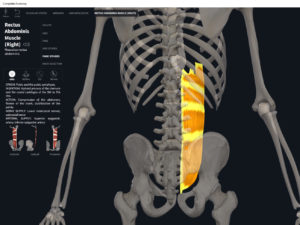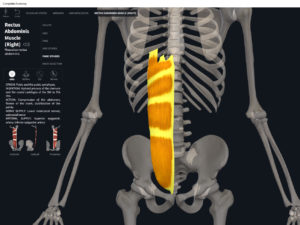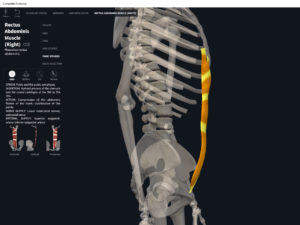Anatomy & Physiology: Muscles—Rectus Abdominis.
Structure.
- Origin: pubic crest and pubic symphysis.
- Insertion: cartilage of ribs 5-7; xiphoid process.
Function.
- Concentric action: spinal flexion (especially lumbar portion), lateral flexion, and rotation; compress abdomen (defecation, urination, forced exhalation, childbirth).
- Reverse mover action: pelvic posterior tilt; lower trunk flexion; ipsilateral pelvic elevation; abdominopelvic conpression.
- Eccentric action: controls/restrains/slows spinal extension, lateral flexion, and rotation.
- Isometric action: stabilization of lumbo-pelvic hip complex.
- Innervation: thoracic spinal nerves T7-T12. Intercostal nerves.
- Arterial supply: superior epigastric artery inferior epigastric artery, terminal branches of subcostal and posterior intercostal arteries.
Clinical Significance.
More.
- https://www.physio-pedia.com/Abdominal_Muscle_Anatomy
- https://www.youtube.com/watch?v=dbwDle81JzM
- https://www.youtube.com/watch?v=HshbNbhC2MI
References
Biel, A. (2015). Trail guide to the body: A hands-on guide to locating muscles, bones and more.
Cedars-Sinai. (2018). Vertebrae of the spine. Retrieved from https://www.cedars-sinai.org/health-library/diseases-and-conditions/v/vertebrae-of-the-spine.html
Clark, M., Lucett, S., Sutton, B. G., & National Academy of Sports Medicine. (2014). NASM essentials of corrective exercise training. Burlington, MA: Jones & Bartlett Learning.
Jenkins, G., & Tortora, G. J. (2012). Anatomy and Physiology: From Science to Life, 3rd Edition International Stu. John Wiley & Sons.
Muscolino, J. E. (2017). The muscular system manual: The skeletal muscles of the human body.



